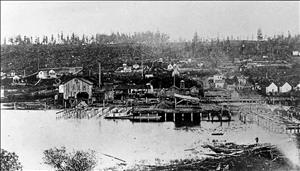In this reminiscence, Dorothea (Pfister) Nordstrand (1916-2011) recalls school days in the 1920s in the marshy land of Seattle's Green Lake neighborhood. In 2009 Dorothea Nordstrand was awarded AKCHO's (Association of King County Historical Organizations) Willard Jue Memorial Award for a Volunteer, for contributing these vivid reminiscences to various venues in our community, including HistoryLink.org's People's History library.
Walking the Dike
I started school at the old Green Lake Elementary School in 1921. Built in 1902, it was a handsome, two story, wooden building with 12 classrooms. An impressive entrance on Sunnyside Avenue boasted eight Greek columns, supporting an upstairs balcony. We were taught this was called a "portico."
There were playgrounds at two levels. The upper area was where the smaller children played, learning games like "In and Out the Window," and "Farmer in the Dell." We jumped rope with a child at each end of a long rope doing the turning, and children jumping into the turning area from either side. Depending on the length of the rope, there might be as many as six syncronized jumpers at a time. If the "turners" were strong enough, sometimes they swung a rope in each hand, circling in opposite directions. It took pinpoint timing to jump into, or out of, the field of action.
Lower playground was for the older children and games like "work up." a kind of baseball where each player moved up a spot as the batter struck out. In season, volleyball nets were set up, or hockey sticks appeared.
Our home was across the marshy northeast end of the lake from the school, in the block west of the Green Lake Library. Green Lake Elementary School was an eight-grade institution, so my older sister and I walked together along the top of the "dike" -- a path on the five-foot-wide ridge that was the top of an earthen dam stretching from Sunnyside Avenue on the north shore of the lake to Sunnyside Avenue on the south shore. It was like walking along the top of a wall. We were grateful for the dike as it was a huge shortcut, saving us from walking the much longer route along Woodlawn through the Green Lake business district.
On one side were the waters of the dammed-up lake, and, on the other, the marshland lay about six or seven feet below the top of the dike. It was a huge wetland, full of cattails and marsh grasses. The birds loved it. It was home to red-winged black birds, blue jays, wrens, chickadees, and many songbirds, as well as ducks and herons. Bright winged butterflies and neon-colored dragonflies abounded there, and we often heard the distinctive croaking of frogs. In the spring, we dipped black tadpoles from its puddles, and brought them to school in glass jars so we could watch them develop legs, lose their tails, and turn into frogs. Then, the whole class would walk down to the marsh to release them back into their natural habitat.
In the fall of the year, we watched the foliage turn from deep green to soft gold, with the cattails making dark brown "exclamation points" of contrast. Rainy days meant nice, big puddles to splash through ... never mind the wet shoes and stockings it cost. A small price to pay for the joy of splashing.
As winter approached, the earthy smell of the marsh was muted as morning frost put powdery whiteness on the stiffened grasses. Some wonderful mornings, there was ice along the edges of the lake and in the open places between marsh reeds. We were forbidden to walk on the ice, but we could stand right at the edge, with just the toes of our shoes touching that enticing slipperyness.
In spring, we watched the burgeoning of new growth, watched birds building nests, and knew the magic of seeing parent birds busily bringing food to stuff into their babies' widely gaping beaks. Families of fuzzy, round ducklings followed their mother ducks in tiny parades. Each morning we counted, to see if they were all still there, and mourned when they were not.
And, the lovely, deep, earthy smell came back -- and the frogs. Today, the dike has been overlaid by the path that edges the lake along East Green Lake Bathing Beach. The marsh was drained many years ago and the area used as a landfill. The resulting added land gave the city a place to build the Green Lake Community Center, Evans Pool, East Green Lake Bathing Beach, many playgrounds, and the park area at the northeast end of the lake.
These have been a wonderful addition to our area, much used and enjoyed by the families of Green Lake and the rest of Seattle, including my own, but I'm glad I can close my eyes and remember the way it was when I was young ... many years ago. I can almost smell the deep, earthy fragrance of that long ago marshland and catch the quick, flashing flight of a red-winged blackbird.

